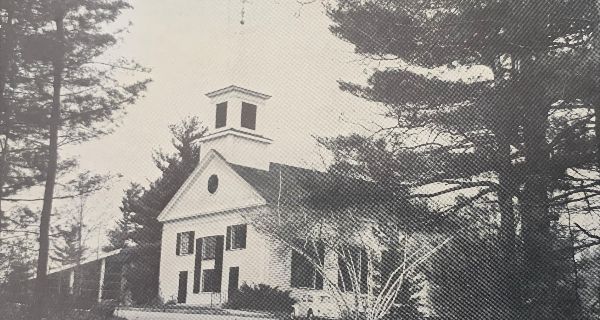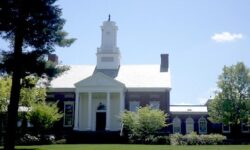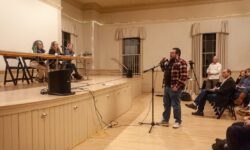By Elisha Lee
Hometown Weekly Contributor
One of the pitfalls of local history is the tendency to see one’s community as an entity apart from its surroundings. In actuality, of course, Dover was a part of Dedham until 1836, and the original Dedham Grant encompassed 200 square miles, stretching from Boston to the Rhode Island border. It is not surprising, therefore, that our history is very much interwoven with that of the surrounding area.
One particularly audible manifestation of this connectivity is the bell in the Dover Church. The church itself was established in 1754 as the Fourth Parish of Dedham. The original structure burned in 1810 and was replaced with a second church in 1811. This structure burned as well in January of 1839 and the bell, cast at the Holbrook Bell Foundry in what is now Millis, was installed with the construction of the third and present church on the site.
In Dover Farms (1914) our onetime local historian, Frank Smith, notes: “the bell put into the second meetinghouse, in 1811, was cast by Paul Revere, and weighed 1,040 pounds. When this meetinghouse was burned in 1839, the bell was taken to East Medway and recast by George Holbrook and hung in the present meetinghouse. As it contains the identical metal proportioned by Paul Revere and is of the same weight, it is in reality a ‘Paul Revere bell’. The first time the recast bell was rung the townspeople all exclaimed, ‘it is the same old bell’. The purity of the tone of this bell has often been remarked. This statement is not in accordance with the parish records, but Mr. George Ellis Chickering, the oldest resident of this town, says he knows it to be a fact, as his father was Treasurer of the parish.”
Smith also tells us that the bell was tolled by the Sexton on Sunday mornings at 9:00 a.m. and again at 10:00 a.m., stopping as the minister ascended the pulpit. When a member of the parish died, the bell was tolled twice for a man and three times for a woman, followed by one stroke for each year of their lives.
Virtually no evidence of the Holbrook Bell Foundry remains to be seen, and yet it was quite well known in its day. Holbrook bells can be found in all parts of the country. The company’s founder, Major George Holbrook (1767-1846), was born in Wrentham and, in his youth, was apprenticed to Paul Revere as a machinist and clockmaker. While best known for his work as a silversmith and for his Midnight Ride, Revere was a man of many talents. In 1787, he established an iron and brass foundry in Boston’s North End where, six years later, he cast his first bell for the Second Church in Boston.
In 1797, after serving his apprenticeship and probably additional employment in Revere’s shop, George Holbrook established himself as a manufacturer of both bells and clocks in Brookfield, Massachusetts. While known to have manufactured case or “grandfather” clocks, much of his horological production appears to have been in the form of tower or steeple clocks. After experiencing a financial failure in 1812, Holbrook left Brookfield for Laconia, New Hampshire and ultimately East Medway, Massachusetts (now Millis) where, in 1816, he established the Holbrook Bell Foundry at the southwest corner of Main Street (Route 109) and Spring Street.
Colonel Holbrook’s son, Major George Handel Holbrook (1798-1875), took over the family business in 1820. In the tradition of his father and Paul Revere, the younger Holbrook appears to have been a man of multiple abilities, being an accomplished musician, frequent director of the Handel and Hayden Society and, in partnership with his cousin Josiah Holbrook Ware, a noted manufacturer of pipe organs. The Holbrook & Ware factory was also situated on Main Street, directly across from the Holbrook bell foundry. The foundry operated until 1880, when Major Holbrook’s grandson, Edwin Handel Holbrook, ceased operations in order to accept a position with the Pension Department in Washington, D.C. The building was demolished in 1890. The organ business continued under the leadership of George Handel Holbrook’s son, Edwin Lafayette Holbrook, until the 1890’s.





















